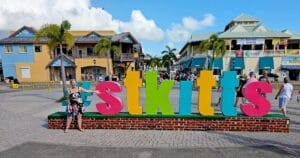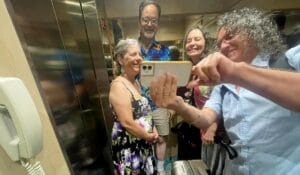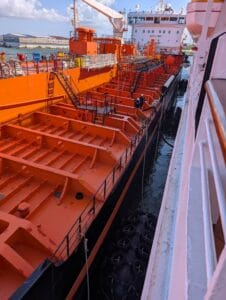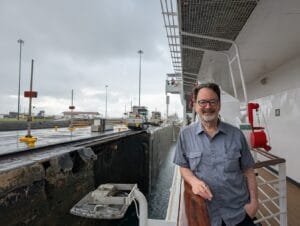90 days of sailing. What an interesting way to measure time and life. But then, measuring time is confounding. Measuring life is something I can get into, though.
In some ways we started our sailing trip with life in Belfast. That time gave us the opportunity to unwind from Las Vegas life and uprooting life twice in nine months. By the time we moved aboard Odyssey, we had a pretty mellow attitude about our upcoming adventures.
Sleeping
Transitioning from land-based living to sea-based living was interesting. I took right to sleeping on the ship. No traffic, alarms, or airplanes disturbed the silence. The air quality improved drastically, according to the monitor I bought in Vegas, much to my relief. No more snotty mornings for me! And the gently rolling and bobbing was soothing.

In contrast, there have been noise, air quality, and movement issues. The HVAC in our cabin is noisy, beyond white noise — even with earplugs — it’s a constant whooshing sound. Our cabin steward had several solutions that we played with to get the degree of cool we needed and the least amount of noise. Various sized leaks around the ship have caused at least musty, if not down-right moldy, conditions that impact my breathing and lung health; I’m learning to avoid some areas of the ship because of that, and hopefully those areas will improve.
The gentle rolling and bobbing turns to rocking and rolling some nights, leading to different sounds in the cabin; the thud of my water bottles hitting the floor and my necklaces swinging and clanking against each other are the most prominent sounds; added padding or securing those items helped a lot. It’s all part of adjusting to sea living.
Weather
I went from wearing long sleeves, layers, and my Irish wool sweater to wearing short-sleeved shirts, and even buying a sun dress to deal with the higher temperatures and humidity once we got to the tropics. The high humidity and temperatures are unpleasant for me so I found I retreated into the air conditioning of the cabin. You can imagine my delight when I woke up the morning we were approaching Peru to find a chilly air. The humidity was still high, which I can tell based on the frizz of my hair, but the layers I chose to put on mitigated that drawback. As I write this, a heavy fog has set in, adding to the feel of a cooler, damper day.

I’m among the small group of people who doesn’t feel the need to go explore every day at every port. I figured I’d go ashore at least once in every port, if even for a bit. The longer we’ve sailed the less inclined I am to go into every port, especially if the port has a reputation for danger or the weather is hot and muggy.
It’s fun to see how different groups have formed in that department. Some go out and explore every time we are docked, some hardly ever go ashore. That difference was highlighted during our seven-day Atlantic crossing; cabin fever seemed to strike hardest on the people who had the highest need to get off the ship at every port.
As our journey progressed, I noticed I did less of the hiking and exploring than I expected. Some of that is due to the ports where we stopped — crime warnings and admonishment to not explore alone — kept me on the ship. I think there was something about the different feeling between a third-world country and a first-world country that slowed me down, too. Even tours were less appealing, though we’ve done some of them.
Regularly, I was astounded by the warmth and sun in contrast to the weather in Belfast. Before leaving home it seemed the joy of spending time in sun and warmth was appealing. The reality is different. Finding shady spots to hang out in is a challenge I hadn’t anticipated and love. There are some wonderful spots on the pool deck that give the breeze to keep my cool and the filtered sunshine to remind me I’m sailing.
Rock the Boat

Learning how to walk without falling on a ship in rough seas has provided many giggles for me. You’ve possibly heard the phrase “walking like a drunken sailor”? That phrase came to mind frequently as I’d attempt to walk down the stairs, hall, around the promenade deck, and down the hallways. I learned that if I attempt my regular stride I’ll be tossed around in a delightfully, crazy way — like a pinball. If I take a wide stance as I walk, I’m actually almost stable. What a great discovery! I’m still careful to use the handrails as necessary, but I love the challenge of walking as straight as possible and giggling at the results.
And with the rough seas I neither fell out of bed nor got seasick. There were some nights I hugged the center of the bed a bit more than usual, and some nights I thought that maybe I should tuck in the sides of the sheets tightly and crawl in from the top (which I never did). It still all went well. To secure a seasick-free time, I did drink ginger tea regularly. The roughest seas were in the Bay of Biscay on the west side of France and north side of Spain. But really, it’s generally been smooth sailing, which pleases me. I was happy we didn’t have to dance with any hurricanes.
Rough Seas?
While we didn’t particularly suffer from it, as we sailed south of the Panama Canal we heard reports that the ports in Peru would possibly be closed because of high waves. We left Ecuador not knowing when we’d next dock. We pulled into Salaverry, Peru, the port for Trujillo, and learned that the port in Manta, Ecuador, where we’d been a week earlier, was severely damaged.

Our next port was to be Callao, Peru (for Lima), and the report was it would have harsh tides so we might not be able to dock there. Even the container ship we were all waiting for was redirected — back to Manta. The travelers aiming for the Galapagos or Machu Pichu scrambled to make alternate arrangements so they could keep their plans. In the end, we did dock in Callao, and the seas were downright calm.
Callao is another container port. These ports in South America have very high security: we aren’t allowed to walk around the port, specific buses and taxis are the only way in and out, and this one is quite a distance from town, and even further from Lima. I’m not going to struggle with going into town — either of them. I have activities onboard to keep me occupied and engaged.
Activities
Getting involved in ship activities was a surprise. The trivia games and dancing that attract many cruisers don’t do anything for me. The two organizational situations I found myself in were different and fun. First I helped organize an election for a representative to the Board of Directors for the ship. It was a great activity to get to know other residents.

Then I was challenged by the entertainment director to start a speaker’s series — SO many of the residents are experts in a huge variety of fields. I took on the challenge and called it Speakers Corner. The speaker chooses their topic and they get up to 45 minutes to talk, plus up to 15 minutes of Q&A. We have them on average every four days. Presentations run from history of places we’ve visited, the biophysics of thermoregulation for hot and cold climates, medieval marriage, Emergency Medical Services, hearing better, strategies to buy a cabin, an introduction to indie films, living in Namibia, and more.
These evenings are wildly popular with anywhere from a quarter to a half of the residents attending. So far the most popular talks were Randy talking about his time as a medic, with such an unexpected upbeat ending several residents were left in tears (previous post), Andy talking about why he most recently lived in Namibia for several years and what he found special about the country, and Randy’s NASA talk, specifically about the Cassini Mission to Saturn, also coming up later online!
Bottom Line
That’s some of the specifics. The question in your mind might be, what’s it like in general?
Some of the things we looked forward to when we contemplated this lifestyle were:
- Community. In general, the people are awesome. We’ve met many friends. It helped that we had a small cadre in Belfast that we could get to know — a core of people who went through some weird times together. Once we got going, the group has kept expanding, to 3-4 times that crowd, and it’s still growing. We haven’t been able to keep up with learning names. But that’s OK: more friends to meet as we continue!
- Food. The quality, variety, and quantity of the food choices has been well beyond “good.” The struggle is to stop when we’ve had enough! If we go to breakfast (rare), we’ll skip either lunch (usually) or dinner. Theoretically, the kitchen is on a two-week rotating schedule, but there have always been new things we haven’t seen before on offer, and we haven’t groaned, “Not that dish again!” even once.
- Worst case scenario: if there’s really nothing on the buffet you really want, there are made-to-order omelettes or other egg dishes available (every breakfast time), and several made-to-order items for lunch/dinner: club sandwich, burger/cheeseburger with fries, pasta with meat/sauces, and sometimes grilled salmon. Randy has occasionally ordered up spaghetti with meat sauce, or a nice pesto cream pasta, but usually there are so many delights on the buffet (or the menu in the sit-down restaurant) that he doesn’t feel the need to.
- Itinerary. There have been changes to the itinerary, back to before we even launched. Because of our late start, we (for instance) missed going to Iceland and the Norwegian fjords, but we know those will be added in once we finish our first circumnavigation. Frankly, we’re not at all worried about “missing” something since we’re here for the long haul, but we understand others might be very disappointed at a bucket list location being skipped since they have set aside a certain amount of time to be aboard.
- “Regular” cruise ships also are forced to change itineraries even when the whole point of a cruise is to see Place X (e.g., Antarctica), and it’s in their contracts that this is a possibility, often without any refunds available. It’s part of the nature of cruising. We have still seen some amazing things and gone places most cruise ships will never get to, and it’s all part of the adventure. And since we plan to “go around” two, three, four, or maybe even more times, with variations part of the plan every time, we’re just not sweating it.
- Expectations. I like to say “expectations kill” — the unexpected is part of the adventure, and demanding that everything goes perfectly is a recipe for destroying your joy. Still, we did have a basic vision of what this lifestyle would be like. Is it as good as we figured it would be? Yes! We have no regrets over selling everything and going on this adventure.
It’s been a good 90 days. I’m looking forward to learning what the next 90 days will provide. It is already a grand adventure.
Originally Published January 3, 2025 — Last Updated January 23, 2025

You have come to this adventure with the perfect attitude. Love following your journey!
Thank you, Patricia, for joining us on our adventure. It’s been a treat — with more to come!
Thanks for this post.
We are in the process of clearing out the house to sell. We’ve done it before.
—
We look forward to welcoming you to your new home. I highly recommend going through all the articles on this site if you haven’t already done so. -rc
What a wonderful life you are leading! I’m envious!
Nancy, we are loving our life and glad it worked out so well. There were times before we left the US we weren’t sure this would work out. The people and experiences we’ve had to date have been worth every bit of energy.
Don’t be envious — be inspired!
—
Good answer. -rc
Great point, Jacira. Live through us vicariously, and without envy. This adventure isn’t for everyone. Pople should enjoy their front row seats. And I’d like some of their popcorn, please. 🙂
Great overview. I look forward to meeting you when I board in June.
—
Cool! -rc
Back at you, Cindy. Stay in touch in the meantime.
I’m enjoying following your adventure.
My main hesitation is about the size of the cabin and not having a wind to open to the outside. Don’t you get claustrophobic at times?
—
No. I can’t answer for everyone, but most view their cabins as a bedroom — a place to sleep and shower. The rest of the ship is “the house,” a wide-open living room, dining room, sitting area, library. Covered and open sky deck areas. Plus, 2/3 of the time we’re in port (and when sailing, it’s very often at night, leaving one at dinnertime and arriving at the next in the morning).
Inside cabins (no windows) are of course the cheapest, balcony cabins/suites the most expensive. In between there are window cabins, and since most want either the cheapest or high luxury, those are the easiest to get right now (read: the others are mostly sold out). So it depends on what you want to afford, and what works for you, but those who have been most “worried” about being cramped either get used to it because of the other amenities, or simply afford to upgrade. -rc
A nice reflection on the past 90 days. Before we left at Tenerife there was a suggestion box placed on the excursions desk. Were the suggestions ever taken up? Did they ever publicise the suggestions? What they were?
—
I’ve heard no mention of what, if anything, was left in the suggestion box. -rc
Like Randy I haven’t heard much about the suggestion box lately. It got moved to the Front Desk, though.
I have a question. How do you do your banking and pay bills? Paypal? Zelle? Check is in the mail? Internet?
—
Mostly the way I did when we lived in Colorado: online. My bookkeeper takes care of any business mail, and deposits any checks (and informs me for records). You can pay the ship fees by credit card or ACH (tapping into your bank account). I do keep some cash for tips and small shopkeepers at ports (most are happy to have US$, bigger ones take cards). We do have Zelle if needed, but even that is fairly rare. -rc
You just answered a whole lot of “wonderings” I’ve had about your adventure. Thank you!
—
We try to anticipate questions. 🙂 -rc
We’ll try to give you more answers to your future wondering. There’s going to be lots more to share. 🙂
Wonderful, as always. Keep ’em coming for those, like me, who are living that life vicariously through you, Randy, and your other wonderful commentators.
As you wish, Mike.
Thanks so much for keeping us landlubbers aware of your experiences. Have you found it easy to continue with your chosen careers while aboard the ship?
—
Essentially yes. I’m needing to get used to some new workflows (especially with shifting time zones), and different working environment, but all in all we’re doing OK. Most residents don’t work anymore, though. We don’t “have to” work to be here, but we both love our work and want to continue. -rc
Yes, and no. In the push to get out of our house and onto the ship, I fell out of work mode. Getting back into work mode is challenging me. I have some new ideas though, so implementing those will change my pattern. It will be pretty easy to work, at least some. 😀
Good post Kit. We, like other commenters, have been curious about life aboard now that several months have passed, and are glad to hear all points except the bit about the ship having leaks. Yoikes! Hopefully the mildew (and the cause!) will be mitigated soon.
Thanks, Matt, for riding along with us. We too hope the mildew and mold won’t be a problem. Some residents have air filters and we are thinking of getting one, too.
Stay tuned for the next installment of “How The Ship Roams”!
Clearly, it’s been awhile since you left the mountainous environment that was causing Randy so many issues, so I would hope things have gotten better. After 90 days, I’m curious if life aboard ship has eased things any further. (Pardon me if I’ve missed any earlier updates about this.)
All in all, I’m happy for you and your experiences, and I’m very happy to have the opportunity to read about them, especially since it’s unlikely I will follow in your footsteps.
—
Ray speaks to my severe allergy crisis that pushed us out of Colorado. Indeed it has improved greatly simply by getting away from the allergens. I think it’ll take a couple of years for my system to fully repair itself, but just getting out of there was most of the battle. -rc
I was wondering last night about provisioning the ship, which may be answered in an upcoming post. Does the ship “go shopping” for food in every port? I suspect most of the food onboard is stored in dry goods pantries or in freezers, but how often do those need to be replenished? And does the ship restock perishable items, like milk or fresh produce, at every port? The logistics of feeding all the residents and staff intrigue me. 🤔
—
I wouldn’t think every port, but certainly frequently. While they certainly have huge freezers and coolers, they definitely want fresh goods too, and it’s someone’s job to know what’s available at the ports we’re going to, and what needs to be purchased. We pretty much always have at least some fresh fruits, veg, fish, and meat, exactly what we have varies as to what is available. From U.K. and Europe we found the beef pretty poor, quality wise, but it got a lot better when we hit the Caribbean and, particularly, the Americas. Meanwhile, we had some fantastic branzino (a variety of sea bass) when we were in the southern Spain/northern Africa region. -rc
The more I read about your adventures the more I want to do this! I love reading all the updates.
—
Well, you CAN. It just means changing all of your life plans. 🙂 -rc
It is a wonderful life — for us, Kimberly. Join us vicariously until you are ready to make the leap. It will alter your life plans. 🙂
This is the stuff I’m really interested in … thank you! What a great adventure you’re having.
Glad this article served you so well. More to come!
I love hearing about how Villa Vie has managed to make the Residential Cruising thing work (for non-millionaires), and following your posts about the life aboard your Odyssey is fascinating to someone who has only been on one (Mediterranean) cruise before. Unfortunately I have family commitments here, and a job I can’t really do from outside the country, but you’re tempting me into at least planning another cruise vacation soon.
One thing I’ve been curious about, however, with the whole ship-as-a-home community concept. You both have digital careers you have been able to continue while being owner-residents aboard, which is convenient for you. (And Kit is finding other ways to keep busy, obviously! 🙂 ) Is there any potential for owners or renters to actually obtain paid employment aboard the ship, maybe part-time? I don’t expect them to actually help run the ship, of course (probably would be a bit awkward) — but maybe something like working in the kitchens, housekeeping, or in some type of ‘customer service’ (front desk, shops, trivia host, etc.) capacity?
Alternatively (or additionally), aside from the ‘office’ area Randy has shown us (which appears intended primarily for “digital nomads” like yourselves), is there anywhere on the ship where some sort of small craft-making business could be (legally) operated? Like for example making jewelry, small wood carvings, embroidery, etc., for ‘export’? I’m sure people would be interested if someone made crafts out of ‘locally’ found materials, or depicting scenes from your various ports of call!
Wistfully imagining a calm retirement at sea, which I obviously can’t afford (yet). Fair winds and following seas to you all!
—
I like that this is sparking thought for you. Actually working for the company is probably a no-go unless you have a position stateside, since blurring the line between onboard employee and resident would probably result in insurance complications. As for crafts, I don’t see why not. Someone (a resident) makes jewelry, and it’s available for sale in the onboard shop. No idea as to how much it sells; if I was in the market, I’d probably be more interested in local crafts from places where we go that reflects local cultures. For instance, I bought a shirt in Peru that reflects that country’s style and color sense in a way that worked for me. Bottom line is, I think onboard crafts is for doing things you like doing, rather than helping to fund the voyage. -rc
If you have a job that lets you work remote, you can do this.
If you can create a paying career that lets you be remote, you can do this.
There are a few people who have careers they can do on the ship, but I doubt they are making lots of money that way.
Keep thinking and start manifesting. 🙂
I have enjoyed the occasional cruise, but one thing I did not like was the *crowding*! Ugh, it was like a floating apartment complex. 5,000 people wandering around made it very hard to relax or enjoy any onboard amenity.
How does it compare to your ship? I imagine it’s much smaller. Can you find places to get away when everyone is onboard?
—
I too have hated the overcrowded cruise ships, and they get worse with every ship generation. See Odyssey: the First Residential Cruising Ship for what I’ve written about the size of our ship. -rc
Craig, Odyssey is much smaller than most cruise ships. Even when it’s at capacity, it will be empty in comparison.
Randy and I walked “against the flow” when a large ship came into dock after we’d been walking around the Tortola harbor. We were so grateful to not have that kind of hoard when we arrived, and not to have such a negative impact on a location.
On the ship, we don’t experience any crowds either. Two dining rooms and several hours of service gives the residents ample room to spread out. Yes, we can find our private space around the ship without resorting to our cabin.
I just read your “The First 90 Days” (even though it’s the end of April). Keep writing. We can and do live vicariously through your adventures. A pet grammatical peeve though — the use of the words further and farther. You wrote, “and this one is quite a distance from town, and even further from Lima.” Farther should have been used. Farther denotes literal distance, further, extent.
Thank you.
—
Since I’m her editor, I should have caught it. Both do mean “more distant,” but farther is in a physical, measurable sense, while further means more of an abstract sense, such as effort or thought. -rc